February 13 – Day 1
It’s hard to decide when the first official day of sugaring season is. Maybe it’s in November, when you walk your sugarwoods and inventory the line damage, cut the fallen limbs off your infrastructure, pull your low-hanging laterals up to keep them out of deep snow. Maybe it’s January 1, when the mind puts the hunting and holiday seasons aside, and cleaning, supply buying, and scheming begins. Or February 1, when the extra daylight really becomes obvious; when the chickadees begin to change their chirps and the red maple buds and the willow branches and the red-osier dogwood twigs start to change color before your very eyes, causing you to think: how am I still not even close to being ready to tap?
I guess for the sake of simplicity, the first official day of sugaring may as well be the day you drill your first hole, which for us was today, February 13. Around 10 a.m. this morning, dad tromped into the farm bush armed with a drill, a plastic felling wedge he’s fond of using in place of a hammer, and a bucket full of check-valve spouts and drilled the first hole. Sap was running – sugar was around 1.7 percent. By the end of the day we had 346 trees tapped.
Valentine’s Day – Day 2
If you’re in any sort of romantic relationship, this is hands down the hardest time of year. By now, nerves have been keenly honed by four months of low light, cold, mud, and slop. Just the other night my buddy was jarred awake by a 2 a.m. elbow to the ribs. “Stop breathing,” his wife admonished him. “You mean snoring?” he replied sleepily. She didn’t answer.
If this resonates, be thankful that sugaring season is finally here. After all, a sugar orchard is the perfect place to rekindle a love affair, or, to start a new one.
No? You didn’t know this?
Sure, sugaring, with all the scalding hot liquid, fly ash, mud, may not seem especially conducive to romantic canoodlings. Factor in the rural Yankees’ not completely undeserved reputation for emotional distance (you’ve heard the one about the farmer who loved his wife so much he almost told her?) and you can be forgiven for thinking: “Mance, you’re feeding us a line of bull here.” But don’t take my word for it. The historical record is full of maple syrup bringing out the inner Dionysus in people.
In 1806, poet Thomas Fessenden rolled up his sleeves and set to work crafting the perfect phrase to describe his lover’s lips. After presumably spending days weighing various options (a peck of apricots? a jar of honey?) he finally settled on: “The lips of my charmer are sweet as a hogshead of maple molasses,” molasses being the colloquial term for syrup in that day.
It gets randier.
In 1852, Gleason’s Pictorial published an article stating: “It is pleasant to visit these sugar orchards, drink sap, lap maple molasses, and make love.” The story goes on to warn: “Let the Vermont ladies beware . . . the delicious saccharine qualities of maple molasses, presented to the swelling lips of a beautiful lass by the hand of a smiling swain, has a wonderfully softening effect upon the head.”
The maple/making love connection is a recurring motif in the visual art world as well. The famous painter Eastman Johnson made a career out of capturing the hedonism of 1800s maple sugaring-off camps in paintings that featured boiling maple sap juxtaposed against party scenes full of fiddlers, round-heeled country girls, and the aforementioned giddy swain. Art historian Brian Allen explains, in a book about Johnson, that the artist equated sugaring-off with love in much of his work. In Allen’s words: “[That] theme is reinforced by the implicit association of flirtation and sweetness and a more specific historical association of sugar with femininity and procreation.”
So there you have it. Forget relationship counseling, just don your wool coat and muck boots, grab your significant other, and find a local sugarhouse where you can get yourself some sugar. In a worse case scenario I am feeding you a line of bull and visiting a sugarhouse will do nothing to salvage your mud-season-strained relationship. But heck, even if, afterwards, you still are getting 2 a.m. rib shots and vaguely threatening spousal admonitions, you can just get up, go to the kitchen, and make yourself a batch of pancakes. Drench the whole thing in fresh maple syrup and your romantic problems will soon be forgotten.
February 15 – Day 3
We were up to 700 taps by the end of the day yesterday and feeling OK about our progress. The weather was too cold for any significant sap run, but warm enough – in the mid-30s – to work comfortably in the woods. In most years at this time, we’re trudging from tree to tree in snowshoes, the wet, heavy snow making our bodies feel 10 years older and slower than they really are. This year’s lack of snow has the opposite effect, and I’m scampering around the woods with the speed and vigor of a 25 year old. We got another 500 trees tapped today, and we were fixing lines as we went.
Tapping trees is an art, and if you’re new to sugaring, here are some ground rules to help you along.
First, use health spouts (5/16 inch). If your grizzled old neighbor insists that he’s been using 7/16-inch spouts for prit near 50 years and buy gawd he’ll change when pigs fly and hell freezes over, just nod your head politely then forget everything he said and use health spouts. They give you something like 90 percent equivalent yield on gravity (near 100 percent equivalent on vacuum), but the holes heal a lot faster. This is better for the tree’s health; it also makes tapping a lot easier for you because you don’t have to search as hard for good wood each time you tap.
Along these same lines, don’t overtap your trees. Trees between 12 and 18 inches should get one tap. Trees over 20 inches can have two. That’s it. “Well buy gawd I been putting foar or foive taps in my trees for prit near . . .” No. Stop listening to him again. Ask him how his production has been over the past few years, and when he tells you, “terrible, the sap just doesn’t run as well today as it did back in the good old days,” this isn’t global warming, it’s simply a reflection of the fact that he’s burned through the tapable wood in his trees by over tapping them. Every taphole leaves a seam of dead wood about two inches to either side of the hole and 6 to 12 inches above it (with traditional spouts and deep holes the scarring is even greater). If you’re drilling your holes 1 1/2 inches deep, it’ll take almost 20 years for the tree to put on enough wood to cover the scarring. If you drill 3 inches deep, almost 40 years. So the more holes you poke in a tree, the more dead wood you’re creating. And the return you’re getting on the extra holes isn’t worth it. On a large tree, a second tap will only produce around 50 percent more sap. This percentage continues to decline the more holes you poke in a tree. So if the idea is to sugar sustainably for years into the future, it’s a good idea not to be greedy.
As for hole depth, we try to get 1–1 1/4 inches of good, white wood in a taphole, which, accounting for 1/4 inch of tree bark, means a 1.5 inch hole. This will be a bit deep for thin-barked trees and a bit shallow for old trees with platy, thick bark, but it seems to be a good average. I don’t have strong opinions about hole depth, and if any of you sugarmakers out there think this is too deep or too shallow, by all means chime in and let me know. There’s conflicting science about the relationship between hole depth and sap yield. It is safe to say, though, that shallower holes heal faster.
So stay away from past tap holes. Drill the hole at a level or slightly inclined angle. “Tap” your spout in, don’t drive it or pound it like it’s a nail, or you’ll never get it out. Make sure your spials are pointed down. Make sure your drops are extended and don’t droop in big Us beneath your lateral line. I know, I know, I’m coming off like a text book. The other important thing to remember is let yourself off the hook when you mess up. You’re going to go too deep or too shallow on some holes. You’re going to miss old tap holes and drill into old wood sometimes. You’re going to have U-shaped drops. We all do it – what separates a good tapper from a bad one is the good tapper recognizes when he or she flubs up and tries to do better the next tree.
February 16 – Day 4
The question on everyone’s mind as sugaring season 2012 gets under way is how the weird winter weather is going to affect the season. We’re on track in Bennington County to have the unsnowiest December, January, and February ever recorded. My plow bill this year? $0.
Conventional wisdom holds that the warm, snowless weather will make the sap less sweet. I’ve heard the rationale behind this as “the trees are burning sugar,” which doesn’t really make sense to me because the sugar content in sap starts low and increases throughout the season. For this logic to hold, it would seem like the trees would start sweet and drop every year, which isn’t the case. I’ve also heard that trees need cold weather and dormancy to convert carbohydrates and starches into sugar, which also seems a little fishy to me, because how can a tree that’s dormant be active? I asked a maple scientist at Proctor Maple Research Center what he thought of the conventional wisdom and he said people have been trying to link winter weather to sap flow/sugar content for decades now without success.
What we do know is that trees run on warm (but not too warm) days that follow cold (but not too cold) nights: 45°F in the day and 25°F at night is the spread often thrown out there. So if we get lots of this kind of weather in the February, March, and April, we’ll all have good seasons. If we don’t, we won’t.
This makes all of us rabid weather watchers. At night during the season when we’re not boiling I’ll find myself mindlessly trolling the weather channels, even though I know the forecast is just speculative after two or three days out. Still, I watch. And worry. I also troll the web for long range forecasts, and this one, from accuweather, seemed especially heartening for sugarmakers around these parts.
The warm trend may continue through the end of February and into March, but temperatures are not expected to be as high as they were in January.
“It looks like the pattern will be similar for most of the country, but not to the same extent,” said AccuWeather.com Expert Senior Meteorologist Jack Boston. “We are getting in a pattern where we’re more susceptible to cold air masses coming down. However, that doesn’t mean they’re going to stay. They’re still going to be progressive. That means cooler temperatures will come in for only a few days, then disappear again.”
Intermittent stretches of cooler air will bring overall average temperatures closer to normal for the months ahead.
“The average will be somewhat above normal, though it won’t be as above normal as January. But, it will be closer to normal,” added Boston.
Boston also stated that he thinks temperatures in the Northeast will begin to drop “just in time for spring.”
“Unfortunately, I can see a pattern developing where we will have cooler-than-normal weather in the Northeast starting later in March and continuing through April. We expect blocking to develop in the atmosphere,” continued Boston. “Basically, that means we’ll see cooler air steered down into the eastern U.S. more frequently. I think that may be setting up in late March and into April, making the arrival of spring a little bit sluggish.”
If February temperatures stay slightly above average, March temps are average, and April temps below average, we could have a really long, good season.
Anyway, we’re still chipping away at the Farm bush, slowly but surely. Lots of squirrel damage this year is making things slow going.
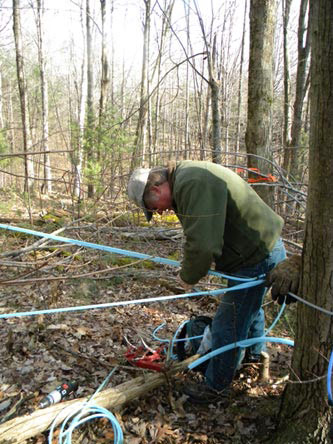
February 17 – Day 5
I spent the morning tapping in the north end of the Farm bush, in an area defined by a mountain stream that appears out of nowhere from beneath a giant ash. The fine sand of the gravel bars is flecked with marble and the water sheets over it like glass. Above where I stand, about a half-mile up towards the top of West Mountain, there was a marble mine in the 1800s. You‘d never know it unless you know it – the forest has long since healed the scars and reduced the chambers to sinkholes and bobcat dens, and yet the fact remains that pieces of Taconic marble helped build Radio City Music Hall, the Jefferson Memorial, and the Supreme Court Building.
You think about history and where things end up when you work any chunk of land. The syrup we produce from these trees gets sent around the world – we’ve shipped as far as Japan. The timber we harvest from this land gets shipped around the country, and the products made from it further than that. A few winters back we harvested a straight-through curly maple from these woods and sold the whole log to a master craftsman. I wonder what palace, church, or mansion that wood ended up in.
Of course, the land was a productive part of society long before us. One hundred years ago, some of this sugarbush was pasture land, which helped to facilitate the sheep boom here in Shaftsbury, Vermont. Some of the trees that were cleared to make way for agriculture were turned into fuel for the forges, furnaces, and foundries that tamed the American West. In those days of primitive iron working, 70 pounds of charcoal was burned for every pound of iron produced. And so the spirit of this Vermont forest is potentially everywhere – on a railroad track leading to Topeka, in a Union Soldier’s horseshoe left on a Virginia battlefield, on a drive shaft in a sunken Boston schooner at the bottom of an Alaskan bay. In the 1700s, trees on this mountain were burned to make potash and shipped back to Britain, where they were used to make gunpowder, bleach, fertilizer, soap, and glass. One mature maple tree could be turned into 40 pounds of ash, which would net the colonist a cool $3.
Erazim Kohak’s idea that “it is as dwellers in time that humans find their place in nature” seems relevant here. Or, it’s not, and tapping is simply a contemplative experience that causes the mind to wander back and forth, back and present.
I’m about a half-day from being tapped out at the farm, and not a moment too soon. The weather is warming up and we should get sap the next few days.
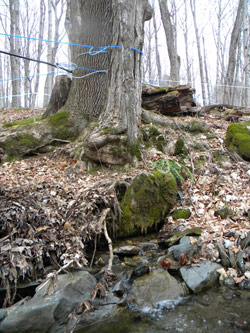
February 18 – Day 6
By 10:30 a.m. today, we had the farm bush pretty much tapped – all told about 1,600 trees. Actually, exactly 1,600 trees, and while there are some lines we didn’t get to, there’s something comfortable about a symmetrical number like that, so we may just leave it there. Our old dairy vacuum pump, which should be producing around 18 inches on these lines, is stuck around 9 inches – an indication that there are lots of little squirrel chews and broken fittings to fix. Plus the weather got warm today and the sap started running in earnest, which makes us anxious to get started on our other sugarbush. In all, we’re slightly over half way tapped.
We get questions every year about whether vacuum pumps hurt trees or not, and the answer is no, because you’re not sucking the sap out of the tree like a vampire sucks blood, you’re just inducing a greater pressure difference between the internal pressure of a tree and the outside pressure, hence producing a greater, but “normal” sap flow.
If you want to learn more about vacuum, check out this experiment conducted at the Proctor Maple Research Center.
February 19th – Day 7
So we tapped all morning up at the Hall bush, and at mid-day we checked the Farm and noted that we had about 1,200 gallons of sap. I went back to resume tapping and Dad started collecting and processing, which is to say he spent the entire afternoon looking for missing tank fittings, gaskets, screws; trouble shooting filter presses and evaporators and ROs; swearing a lot, losing things, trying to remember what went where and how. I share this in the hopes that you other disorganized sugarmakers out there won’t feel alone. A sugaring operation is a great big clunky machine that lies dormant for 10 months out of the year. And just like starting an old vehicle that’s been sitting around for 10 months, it’s a royal pain in the ass to get things up and running after such a long lag time.
RO, for those of you who don’t remember, stands for Reverse Osmosis. Picture a high-tech looking rectangle, about the size of a small closet, which runs on electricity. It’s basically a high-pressure pump hooked up to an enormous filter. The filter is, more accurately, a semi-permeable membrane that will allow water molecules to pass through but not sugar molecules. Sap is about 98 percent water. When it gets blasted through the membrane, clean, diluted water comes out the other side, and the remaining sap is correspondingly sweeter. We’re taking about three-quarters of the water out of the sap before we boil it, so 1,000 gallons of 2 percent sap becomes 250 gallons of 10 percent concentrate before it even hits the pan. Our machine concentrates 1,200 gallons of sap an hour.
Anyway, this year we discovered one of the high pressure pumps in our RO is bad – an irony since the machine worked fine last season, but was recalled this summer and the pumps replaced free of charge. CDL, the manufacturer, promised to send a guy with a new pump down Monday, so we’ll limp through with one membrane on this first batch of sap and take them at their word.
Around 3 p.m., we kindled a fire in the old wood-fired evaporator and struck a match. The flame transferred to a strip of birch bark, where it clung for a moment, hesitantly, before deciding, “Sure, I can gobble this up.” Once the kindling began to snap, I shut the doors and turned on the force draft, and in moments the shy flame had turned into a roaring inferno. Twenty minutes later a thick plume of steam was rising from the pans and swirling around the room before meandering through the cupola and touching the sky.
The Nearings, in their Maple Book, suggested that running an evaporator is sort of like flying a plane. “An expert pilot listens to the throbbing of his motor and every creak and snap and hum of his plane, so does an expert boiler know every sound of his evaporator. A lowering in the pitch of the boiling, a drip or a sizzle where there should be none has him on an immediate tour of inspection to test that all is in order.” It’s a good analogy, and our senses were especially heightened today, this being our maiden voyage.
Friends came by throughout the evening to smell steam and visit. Cold beer flowed in honor of Spring’s arrival. In a few hours the first syrup of the year came off – a robust medium amber. By all reports it was great tasting.
Syrup to date: 10 gallons
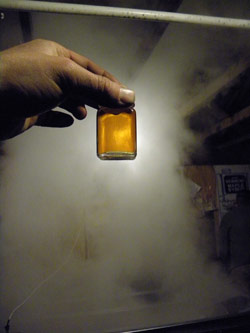
February 20 – Day 9
Our farm bush sits in the Taconic Mountains, where maples mingle with bitternut hickories and black birches and red oaks. This sugarbush orients east, so it gets a lot of sun and heat. It’s a mixed aged sugarbush. Some sections feature monarch trees – as big as any maples you’ve ever seen – that have been actively sugared for at least 90 years. Other sections feature small trees typical of regrowing pastureland.
There are parts of this 40 acre wood that don’t seem to want to be a sugarbush. Yes, we steer the succession towards hard maple and we force the issue, but it’s work. In the more north-facing, wet sections the maples flourish, but on the higher, ledgier ground, the beech and oak are formidable competitors.
The Hall bush, on the other hand, is, from a site perspective, a maple’s dream. It sits seven miles away, over on a limey knob, at the base of the Green Mountains. It’s largely a maple/hornbeam monoculture, and faces west and north. In the summer, the ground is carpeted with rich-soil indicating plants.
No sugarmaker covets a north-facing bush, but walk in these woods and it’s clear that the land wants to be a sugarbush. It has perfect pitch, in both the slope sense of the word and in the idea that it feels, and looks, and acts like a sugarbush. We’re thankful that the Hall family, from whom we lease the bush, agrees with us that it would be a shame not to manage it this way.
I spent about 9 hours at Hall today, joined at various times by friends and helpers. A light coating of snow made the ground a story: deer, bobcat, fisher, and squirrel tracks bore testament to the previous night’s unfoldings.
The one animal we saw in the flesh was a porcupine, perched precariously in the crown of a hornbeam. Why these relatively large animals choose to hang out on tiny, pencil-sized branches, 40 feet up in the air, is beyond me. Or how. In any case, his presence illicited mixed emotions in me. As an 18 year old I would have promptly marched down the mountain, got a gun, come back, and shot him. They girdle and kill maples, after all. They like salt, and we use bare hands on our tubing, and so it’s not unreasonable to suspect that there could be a conflict here. But as I’ve gotten older, I’ve gotten softer. Killing things just to make them dead doesn’t feel as useful as it once did. So I told him he’d better stick to hornbeam if he knows what’s good for him, and I got back to work.
It was a cold, blustery day. By the time the setting sun began to color the bare tree crowns we’d tapped around 900 trees. I went home and ate like a wolf, then put my back towards a glowing woodstove and was fast asleep by 8.
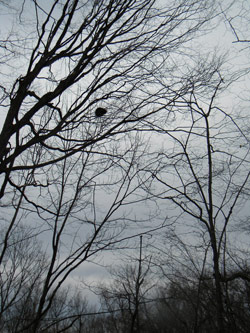
February 21, 2012 – Day 9
Spent the morning editing copy, then hit the Hall bush this afternoon and met up with Nate and Dad. We got the rest of the easy stuff tapped, which brought our tap count at Hall up to 1,100 and our total count to 2,700.
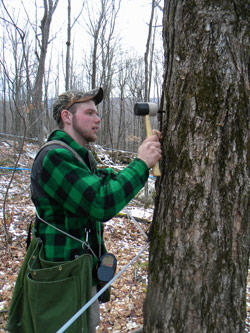
February 22, 2012 – Day 10
Yesterday it only hit about 37 degrees here after nighttime temperatures fell into the low teens. Consequentially, it took the trees a long time to warm up, and they began trickling around noon. Last night it didn’t freeze, but the sap trickled all night. By afternoon temps were in the low fifties and we had around 1,600 gallons of sap
As you Catholics all know, today’s ash Wednesday, and in an odd moment of convergence I found myself cleaning out the ashes in the evaporator while Emmylou Harris’s pretty voice crackled from the wall mounted radio, singing: “We’ll sweep out the ashes in the morning.”
The CDL guy came Monday as promised, replaced the bad high-pressure pump free of charge, and the RO is squeezing to 11 percent. Dad, Trev, Nate and I boiled until about 11:30 p.m., joined for a good chunk of it by our friend A.M., who’s back in town after a 2-year teaching stint in Savoonga, Alaska. The syrup we made was straddling the edge of fancy and medium. It was the color of gold.
Syrup to date: 35 gallons
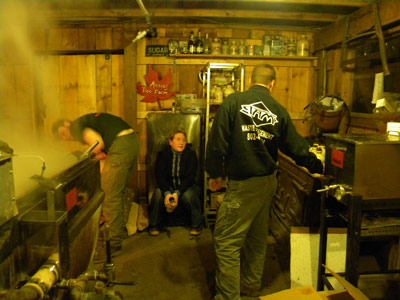
February 23, 2012 – Day 11
You know what would be really cool? If we discussed maple equipment here, and all of you other sugarmakers chimed in. Here’s a rough list of things to get us started that I consider good, bad, and meh (i.e., somewhere in the middle). Chime in and tell us what you think.
Good:
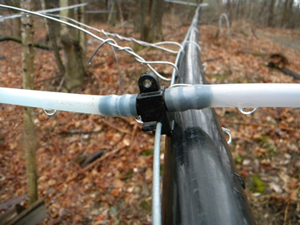
Hooked lateral connectors – the ones that snap right on the mainline wire. Used to be you had to employ all kinds of silly and only partially effective tricks to tighten your lateral lines. Nails. Wire. Chinese finger traps. Now, you simply snap and go. How did we ever live without this fitting?
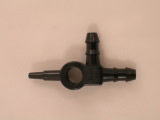
End Rings. If you use a T, or a Y, or an end ring that dead-ends, you’re going to get a slug of dirty, bacteria laced sap that sits in your lines forever. With these fittings you don’t have that problem. I love them for this.
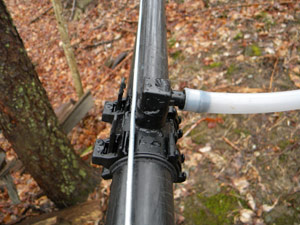
D and G Mainline saddles. We like these, and when they’re installed properly, I don’t notice any vacuum leaks, something I can’t say for some of the other mainline fittings on the market.
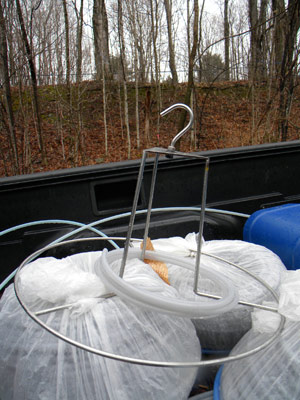
Tubing reel. You used to have to flop lateral line around and around your arm – like a hula-hoop – while you were walking through the woods to unstring it. Now, just hang this tool from your mainline and walk away.

Stainless steel barrels. Yes, they’re expensive. But if you’re committing to sugaring for the long haul, they’re a sound investment. It used to be a terrible feeling putting your syrup into galvanized drums (which as of January 1st are illegal to use in Vermont) that had flecks of rust in them, or medium amber syrup into plastic bulk containers that you knew would be dark amber by the time you took it out. With good stainless barrels, we’ve held syrup for two or three years and it’s come out the same color and flavor as when we put it in.
Meh:
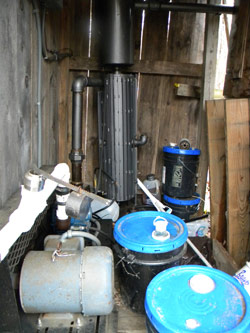
Dairy vacuum pumps. They’re good because they’re cheap and easy to come by. They’re bad because they only pull 18 or 20 inches of vacuum and they’re not designed to be run constantly.
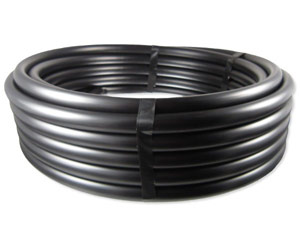
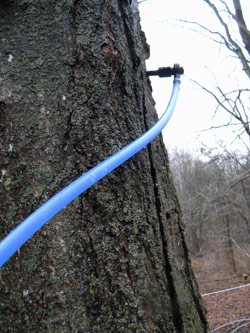
The current drop lines. They’re getting better, but they’re still only meh.
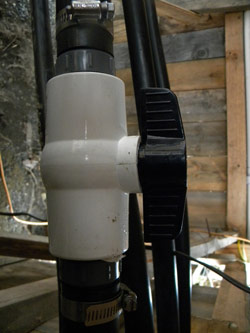
Plastic ball valves. Great because they’re cheap. Some will last 10 years. Some will shatter during your first hard freeze.
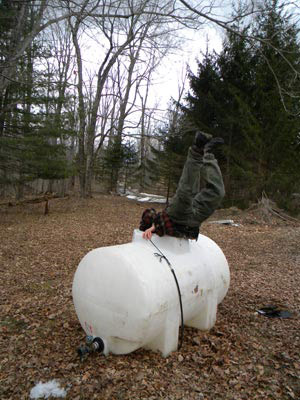
Plastic gathering tanks. Cheap, light, easy to fling around, but plastic is harder to clean than steel. And if you have one with an opening that’s too small to crawl into (or too small to provide 360° access with a pressure washer), you’ll never get it clean.
Bad:
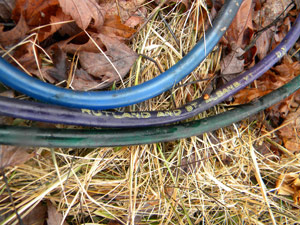
All drop line that was made before 5 years ago. By the end of the first season you couldn’t even see through most of this old crap drop line. Pictured here are some relics pulled off the forest floor in our sugarbush.
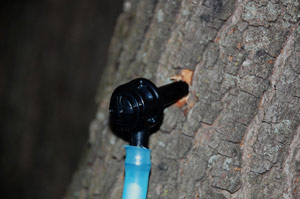
Single piece spiles. Tapholes “close” when bacteria, from the air or from your lines, creates that mucusey lining you see in April. Thus it makes intuitive sense to me that if you use a clean spile, you’ll be ahead of the game. I’m not ready to endorse the check valve spiles over conventional two-piece spiles yet (though I will point out that Cornell tested them last season and had superior results and I will say that we’re using them exclusively.) But two piece spiles, which give you a fresh, clean tip to use every year, seem clearly superior to the old one piecers that sit in the woods all summer.
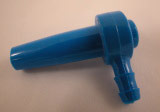
7/16 spiles. Their time has passed.

Star fittings. They don’t distribute vacuum well. They break easily. Their high profile can be a pain to hook into. Far better, I think, to just use a standard inline fitting.
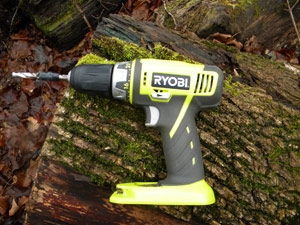
My wussy Ryobi drill. I’m mad at it lately because the batteries don’t hold a charge well and it’s just too light and weiny to be good for heavy tapping use. Spend the extra money to buy a powerful cordless drill.
Anyway, we boiled off another decent run last night and made light fancy syrup.
Syrup to date: 60 gallons
February 27, 2012 – Day 14
Boiled Saturday, but the weather was too cold for a good sap run this past weekend. On Sunday, Dad chased the pans with water to clean off the whitish sugar sand that had accumulated there. We’re up to around 100 gallons. On Sunday, I visited a Rupert, Vermont sugarmaker who had already made 1/3 of a crop. There’s no telling how the season is going to end up, but there’s no question that we’re all off to a fast start.
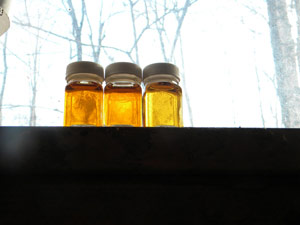
February 28, 2012 - Day 15
When you’re a producer writing about maple sugaring, you have to be careful not to fall into public relations prose. Probably the easiest place to do this is when discussing taste, as in “the syrup was great tasting,” a line you’ll find in Day 7’s entry of this very blog. I might have been more specific and said the syrup was “on-flavor medium amber,” which leads us into a discussion of flavors, colors, and grading that may be useful for those of you who are new to sugaring.
As most of you know, maple syrup comes in different grades, though you might not know that sugarmakers have no control over the process. (There’s a caveat here that involves air-injection units, but we’ll get to that another day.) As a general rule, the syrup starts light and gets progressively darker as the season unfolds and temperatures rise. Tree sap is a perishable item – like milk – so it degrades as it ages and gets warm. In the early season, when temperatures are cold, sap stays cool longer and thus usually produces a lighter syrup. The color also reflects the inner workings of the tree as it progresses towards bud-break, though I don’t have the requisite information on hand to speak with any scientific authority on this.
The taste changes as the color changes. As a general rule, early season syrup is the color of domestic pilsner beer – more golden than amber – and has a very sweet, delicate taste. In Vermont, we call this Fancy; in most other Northeastern states it’s called Grade A Light Amber and in Canada it’s Canada No. 1 Extra Light (AA).
As the season progresses and the syrup gets darker, its flavor becomes more complex. The next grade up is called Grade A Medium Amber in all the states (and Canada No. 1 Light across the border). It’s your standard, amber-colored, middle of the road syrup that has most of the Fancy grade’s sweetness but with more mapley overtones.
Grade A Dark Amber comes next (Canada No. 1 Medium (B) up north), which is the color of a micro-brewed ale and features a pronounced maple flavor.
The darkest retail grade of syrup is the color of porter and, in New York, is called Extra Dark for Cooking, which is dumb because many people find this to be a superior table syrup and the word “cooking” puts restrictions in a consumer’s mind (“No, honey. That’s the ‘cooking syrup.’ We want something for pancakes.”). In Vermont and New Hampshire, it’s called Grade B, which may be even dumber. Why on earth would you intentionally label a product as Grade B anything and expect consumers not to think of it as an inferior product to Grade A? (It’s not inferior, it’s just different.) Or call something Number 2 Amber, as Canada does? (“We’re number 2!” We’re number 2!”) Maine is the state that has it right, labeling it Grade A Extra Dark Amber, which is exactly the right description. As my rant probably indicates, Grade B is my favorite kind of syrup for the table.
In Vermont and Maine, anything darker than Grade B/Grade A Extra Dark Amber gets labeled Grade C and can only be sold in bulk and used in commercial applications (maple flavoring, sugar production, etc.). Canada calls this No. 3 syrup. New York and New Hampshire don’t distinguish between Grade B and Grade C, which is the logic that puts my above rant into perspective. Yes, syrup does reach a point where it starts tasting funky. C can be red in color or tar-colored, and the taste is very volatile and unpredictable. Sometimes it tastes OK – like bitter dark chocolate. Sometimes it’s just plain bad. So it is important to indicate to consumers that this syrup truly is inferior to the table grades.
I’ve got to get out and walk lines this morning, so we’ll pick up this line of thought tomorrow with a more thorough examination of on-flavor versus off-flavor.
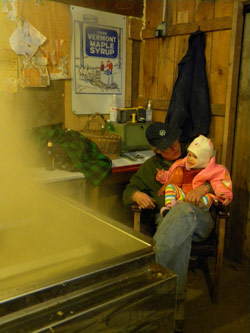
February 29, 2012 - Day 16
Dad and his granddaughter Tessa, a fourth generation sugarmaker, boiling sap.
Tessa: “Dat?”
Dad: “Evaporator.”
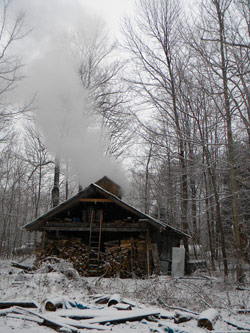
March 2, 2012 - Day 18
The sap trickled down here Monday, then ran decent on Tuesday. On Wednesday morning we gathered and started processing. It was a cold, blustery day. The sky was heavy with moisture and by noon snow had begun to fall. They called off school and Nate swung by the sugarhouse and boiled with us. We finished for the night around 10 p.m. after a 38-gallon day.
So to resume the grading/color/flavor discussion from earlier in the week, now you know that there are different colors of syrup and different flavors associated with the colors, but this is only part of the story, as the taste of syrup changes every day. No two barrels of syrup taste exactly alike, even if they’re both Grade A Medium Amber.
Now if the syrup’s “on,” as we tend to call it, the taste differences from batch to batch will be subtle. The basic flavor profile will be there, but there will be pleasant hints/shades/complexities that make each draw one of a kind. “Off” syrup is syrup that strays from the basic flavor profile, or features hints of something unpleasant.
Ask a scientist what accounts for the subtle differences in syrup taste and he or she might chalk things up to the variety of microorganisms that exists on the tree and in your tubing system. In the beginning of the year when things are cool, and if you use clean practices throughout the sap-to-sugar chain, you limit microbial contamination, thus producing nice, clean, light fancy syrup. As things warm, these microorganisms grow rapidly in sap. They clog up your taphole and tubing, but they also affect the taste. They create higher invert sugar levels, a higher degree of caramelization, and a dark color. According to my producer’s manual, in the beginning of the season you might have less than 1,000 microorganisms per milliliter of sap; by the end of the year, when the sap is cloudy and lactic-looking, microbial loads may be as high as one trillion per milliliter.
Ask an English major what causes the subtle differences in syrup taste, and they might say “terrior” – this notion that geography effects flavor. For instance, I might say that the taste of my syrup is influenced by the limestone deposits in my sugarbush; by the rich fecundity of the Valley of Vermont. You can tailor a similar claim to your backyard: just combine your state and region with words like “verdant” and “calciphilic.” Now as you’re picking up on, I was a Communications major, so I can’t buy this whole heartedly, but I do appreciate the imagination here, and I’ll play along and buy it to a certain point. I’ve been told that roadside maples can pick up a sodium taste from road salt, so if this is true, why couldn’t other minerals affect flavor in a positive way? Of course, even as I write that line my inner skeptic is pointing out that because syrup taste changes so much and so frequently, and is being influenced by literally hundreds of other factors (or trillions, if we consider microogranisms), it just seems impossible to tease “place” out and say: “that’s causing this taste.”
Off-flavors are both easier and harder to quantify. Some, like those known as “buddy” and “metabolism,” are organic, and there’s really nothing you can do about them as a producer. “Buddy” syrup has been described as tasting chocolaty or butterscotchy; “metabolism” flavor is woody or popcornish with hints of peanut butter and cardboard. I’m not making a joke here; this is all from my producer’s manual.
Thankfully, most off-flavors represent producer error and thus can be corrected and controlled. The niter on your pans changes flavor, the acid you use to keep the niter off your pans changes flavor, the defoamer you use to keep bubbles low can change flavor, the filters, the tanks, the containers, pretty much everything you do can effect flavor. One off-flavor in the manual is called “scorch.” Taste: “burned.” Cause: “burning of syrup.” Solution: “don’t burn syrup.”
Anyway, there is tons more to say on this subject but not enough time to say it. One obvious question here is how does sap from different kinds of maple trees affect taste? In other words, what does pure red maple syrup taste like compared to pure hard maple syrup compared to pure box elder syrup. And I don’t have a good answer. If any of you do, let us know.
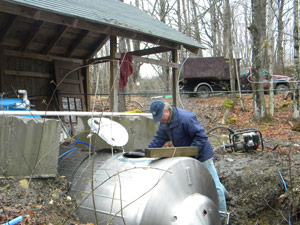
March 6, 2012 - Day 22
The sap ran well last weekend, which led to a 17-hour workday on Saturday and a 12-hour day on Sunday. Still making fancy; in fact, we haven’t made a bit of dark amber yet, which for us is unusual. Our older tubing infrastructure and the lack of pitch at the farm bush are usually a recipe for darker syrup. Then again, it is only March 6, so I guess it’s not that unusual. What’s strange is that the season is two weeks ahead of schedule. We’re usually just making the first syrup of the year around now; this year, we’re well over 1/3 of a crop.
The weather has been a rollercoaster of late, whiplashing between scary-highs near 55° last week into near sub-zero readings the past few nights. Now they’re saying right back up to 50’s tomorrow, and on Thursday it’s supposed to hit 60 degrees, which is way too warm. The 60 degree mark is never a good thing to see, and we’re worried about what it might do to our grade and sap flow.
Syrup to date: 245 gallons.
March 8, 2012 - Day 24
It was 30 degrees yesterday when I woke up at six. Thirty two by around 7:30. I was trying to get caught up on some Northern Woodlands work, but the weather was having none of it. Thirty five by 8 – I went up to turn the vacuum pumps on. Everything was frozen up pretty bad after two days of real cold but the sun was warm. The sun felt like April. After pulling the ice out of the releasers I got the pumps going and the lines started gushing slush. You could just tell from that hot sun that the slush wouldn’t last long. The vacuum levels were really low on both pumps, meaning there were problems with the lines. Warm weather and high sap flow followed by single-digit cold like we had the past few nights is a recipe for line separation – the ice expands and the lines pull apart at the connectors. There was a lot of work to be done in the woods.
Went back home and worked until lunch. By then it was 55 degrees. Heard a forecast on the radio saying that next week we’re going to have sustained 50s and 60s here – a week of that can kill a season. Figured we’d better make syrup while we can, so I spent the afternoon chasing vacuum leaks in both sugarbushes. By the end of the day the farm was up to 18 inches – right around where it should be. Hall was at 15 out of 25. The mainlines had separated in three different places (and I’m afraid I missed one at Hall, judging by the low number).
It takes us about an hour round trip to go from the sugarhouse to either bush and collect 800 gallons of sap, so we worked in the woods until dark and then started collecting. Dad did one load I did the other. While pumping at the farm, a hazy, ovoid moon glowed from behind clouds in the east, and the western sky was mottled with contrails and reddish northern lights. They weren’t bright, like you see in the photographs of the far north, but they were significant enough to make the sky look like I’ve never seen it look before.
As I write this it’s 5:30 a.m. on Thursday and I have 2,400 gallons of sap waiting to be boiled. They’re saying highs of 62 today. I got to go.
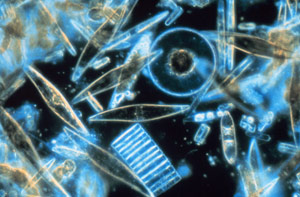
March 9, 2012 - Day 25
Dad was on the road by 6 a.m. to get another load of sap; I fired the rig up just about the time the sun was cresting bald mountain. It was 50 degrees and rising outside; felt and sounded like May. Outside the air resonated with bird song, including two tom turkeys who were chokolokolokoin back and forth.
I changed the filters in the RO, bled the intake line, pressed “start.” The high pressure pump kicked in like a little jet engine and spiked the pressure gauge up to 400 PSI. Once I’d made sure the water was going into the permeate tank and the concentrate up into the bulk tank in the eves, I set to work kindling a fire in the evaporator. Once the birch splints were crackling I did a walk around, checking the rig over for problems. Levels looked good. No leaks. As the fire gained momentum, niter began popping off the bottom of the front pan – mini, muffled explosions like a fireworks display in the next town over. It’s normal, but does indicate that the front pans need to be acid-washed. Question for you other sugarmakers: what do you use to clean niter scale?
Soon the sap in the pans began to hiss and faint tendrils of steam began to rise. I scooped out the sap scum that had accumulated in the back pan (picture the foam that appears in the backwaters of rivers and streams). Next, I heated some water and wiped down the canning tanks, the buckets, the stainless sides of the evaporator until they shone with sheen.
By now the fire needed tending, and I stirred the coal bed with a large iron poker, then crammed the firebox full again. The boiling began in earnest. There’s a temperature gauge on the side wall connected to a probe that lets me watch the liquid in the pans race to 212 degrees, then creep towards 216. I broke out the filter press and began to reassemble it, staggering the eight waffle plates between the cake plates and carefully placing filter papers at each union. The way these things work is you mix DE (also called filter aid, and technically called “food grade diatomaceous earth”) into the hot syrup that comes off the evaporator, then you pump the syrup through the filters. The “cake” filter plates fill with DE, and as the syrup recirculates, it flows through the cake and the adjacent filter papers, which scrubs the syrup clean.
Diatomaceous earth is a chalk-like sedimentary rock that’s made up of the fossilized skeletal remains of single cell organisms that existed millions of years ago; their pointy edges provide the scouring power. When you tell people that you filter your syrup with fossils, they tend to have follow up questions, like:
Are the diatoms plants or animals? This is a tricky question, because they’re algae, so to be technically correct, they’re “organisms.” If this answer gets a blank look, just say “plant,” and hope there’s not a botanist within ear shot to argue with you.
What do they look like? They’re sort of a random assortment of shapes – see picture above.
How old are they? Most of the commercial deposits are freshwater deposits that are between 24 million and 100,000 years old, but some salt water deposits are twice that age.
Where do they mine DE? All over the world, though no where locally that I know of. Something I read suggested that New York and New Hampshire have known diatomaceous sediments in existing lake bogs, but the sources are “undeveloped.”
Anyway, I was soon drawing off every 10 minutes or so, and we kept up this pace until 3 p.m., at which time we simmered through a collection, then fired everything up again. We were done by 9. In all it was an 80 gallon day. 90 percent of the sap came from the farm bush, which ran like gang busters. The Hall bush shut down in the heat, or never got going, I can’t tell which. We’ve gotten nothing out of that bush in the past two days – just a measly 200 or so gallons of ugly, milky sap.
Syrup to date: 325 (approximately)
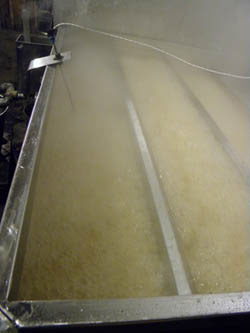
March 13, 2012 - Day 29
Boiled with friends and family on Saturday; sap flow was minimal. Sap ran well on Sunday, then it froze on Sunday night. Monday it poured at both bushes and we boiled all day – by evening we’d made around 80 gallons. They’re saying highs in the 60s to near 70 all week and no freezing temperatures at night. Is this the end? Stay tuned…



Discussion *